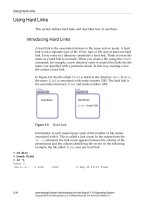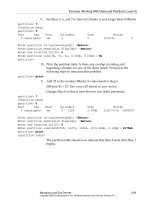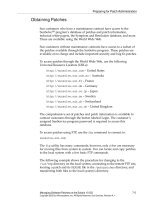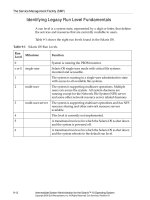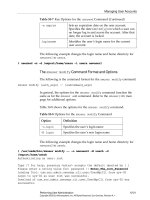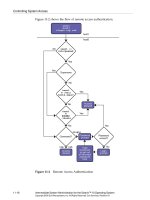System administration guide oracle solaris 9 containers
Bạn đang xem bản rút gọn của tài liệu. Xem và tải ngay bản đầy đủ của tài liệu tại đây (4.11 MB, 48 trang )
Simpo PDF Merge and Split Unregistered Version -
System Administration Guide: Oracle®
Solaris 9 Containers
Part No: 820–4490–14
April 2011
Simpo PDF Merge and Split Unregistered Version -
Copyright © 2008, 2011, Oracle and/or its affiliates. All rights reserved.
License Restrictions Warranty/Consequential Damages Disclaimer
This software and related documentation are provided under a license agreement containing restrictions on use and disclosure and are protected by intellectual
property laws. Except as expressly permitted in your license agreement or allowed by law, you may not use, copy, reproduce, translate, broadcast, modify, license,
transmit, distribute, exhibit, perform, publish or display any part, in any form, or by any means. Reverse engineering, disassembly, or decompilation of this software,
unless required by law for interoperability, is prohibited.
Warranty Disclaimer
The information contained herein is subject to change without notice and is not warranted to be error-free. If you find any errors, please report them to us in writing.
Restricted Rights Notice
If this is software or related documentation that is delivered to the U.S. Government or anyone licensing it on behalf of the U.S. Government, the following notice is
applicable:
U.S. GOVERNMENT RIGHTS
Programs, software, databases, and related documentation and technical data delivered to U.S. Government customers are "commercial computer software" or
"commercial technical data" pursuant to the applicable Federal Acquisition Regulation and agency-specific supplemental regulations. As such, the use, duplication,
disclosure, modification, and adaptation shall be subject to the restrictions and license terms set forth in the applicable Government contract, and, to the extent
applicable by the terms of the Government contract, the additional rights set forth in FAR 52.227-19, Commercial Computer Software License (December 2007).
Oracle America, Inc., 500 Oracle Parkway, Redwood City, CA 94065.
Hazardous Applications Notice
This software or hardware is developed for general use in a variety of information management applications. It is not developed or intended for use in any inherently
dangerous applications, including applications that may create a risk of personal injury. If you use this software or hardware in dangerous applications, then you shall
be responsible to take all appropriate fail-safe, backup, redundancy, and other measures to ensure its safe use. Oracle Corporation and its affiliates disclaim any
liability for any damages caused by use of this software or hardware in dangerous applications.
Trademark Notice
Oracle and Java are registered trademarks of Oracle and/or its affiliates. Other names may be trademarks of their respective owners.
Intel and Intel Xeon are trademarks or registered trademarks of Intel Corporation. All SPARC trademarks are used under license and are trademarks or registered
trademarks of SPARC International, Inc. AMD, Opteron, the AMD logo, and the AMD Opteron logo are trademarks or registered trademarks of Advanced Micro
Devices. UNIX is a registered trademark of The Open Group in the United States and other countries.
Third Party Content, Products, and Services Disclaimer
This software or hardware and documentation may provide access to or information on content, products, and services from third parties. Oracle Corporation and
its affiliates are not responsible for and expressly disclaim all warranties of any kind with respect to third-party content, products, and services. Oracle Corporation
and its affiliates will not be responsible for any loss, costs, or damages incurred due to your access to or use of third-party content, products, or services.
Copyright © 2008, 2011, Oracle et/ou ses affiliés. Tous droits réservés.
Ce logiciel et la documentation qui l’accompagne sont protégés par les lois sur la propriété intellectuelle. Ils sont concédés sous licence et soumis à des restrictions
d’utilisation et de divulgation. Sauf disposition de votre contrat de licence ou de la loi, vous ne pouvez pas copier, reproduire, traduire, diffuser, modifier, breveter,
transmettre, distribuer, exposer, exécuter, publier ou afficher le logiciel, même partiellement, sous quelque forme et par quelque procédé que ce soit. Par ailleurs, il est
interdit de procéder à toute ingénierie inverse du logiciel, de le désassembler ou de le décompiler, excepté à des fins d’interopérabilité avec des logiciels tiers ou tel que
prescrit par la loi.
Les informations fournies dans ce document sont susceptibles de modification sans préavis. Par ailleurs, Oracle Corporation ne garantit pas qu’elles soient exemptes
d’erreurs et vous invite, le cas échéant, à lui en faire part par écrit.
Si ce logiciel, ou la documentation qui l’accompagne, est concédé sous licence au Gouvernement des Etats-Unis, ou à toute entité qui délivre la licence de ce logiciel
ou l’utilise pour le compte du Gouvernement des Etats-Unis, la notice suivante s’applique :
U.S. GOVERNMENT RIGHTS. Programs, software, databases, and related documentation and technical data delivered to U.S. Government customers are
"commercial computer software" or "commercial technical data" pursuant to the applicable Federal Acquisition Regulation and agency-specific supplemental
regulations. As such, the use, duplication, disclosure, modification, and adaptation shall be subject to the restrictions and license terms set forth in the applicable
Government contract, and, to the extent applicable by the terms of the Government contract, the additional rights set forth in FAR 52.227-19, Commercial
Computer Software License (December 2007). Oracle America, Inc., 500 Oracle Parkway, Redwood City, CA 94065.
Ce logiciel ou matériel a été développé pour un usage général dans le cadre d’applications de gestion des informations. Ce logiciel ou matériel n’est pas conçu ni n’est
destiné à être utilisé dans des applications à risque, notamment dans des applications pouvant causer des dommages corporels. Si vous utilisez ce logiciel ou matériel
dans le cadre d’applications dangereuses, il est de votre responsabilité de prendre toutes les mesures de secours, de sauvegarde, de redondance et autres mesures
nécessaires à son utilisation dans des conditions optimales de sécurité. Oracle Corporation et ses affiliés déclinent toute responsabilité quant aux dommages causés
par l’utilisation de ce logiciel ou matériel pour ce type d’applications.
Oracle et Java sont des marques déposées d’Oracle Corporation et/ou de ses affiliés.Tout autre nom mentionné peut correspondre à des marques appartenant à
d’autres propriétaires qu’Oracle.
AMD, Opteron, le logo AMD et le logo AMD Opteron sont des marques ou des marques déposées d’Advanced Micro Devices. Intel et Intel Xeon sont des marques ou
des marques déposées d’Intel Corporation. Toutes les marques SPARC sont utilisées sous licence et sont des marques ou des marques déposées de SPARC
International, Inc. UNIX est une marque déposée concédé sous license par X/Open Company, Ltd.
110413@25097
Simpo PDF Merge and Split Unregistered Version -
Contents
Preface .....................................................................................................................................................7
1
Introduction to Solaris 9 Containers ................................................................................................ 11
About Branded Zones ......................................................................................................................... 11
Components Defined by the Brand ........................................................................................... 12
Processes Running in a Branded Zone ...................................................................................... 12
General Zones Characteristics ........................................................................................................... 13
General Zones Concepts ..................................................................................................................... 13
About Oracle Solaris 9 Branded Zones ............................................................................................. 14
Oracle Solaris 10 Features Available to Zones .......................................................................... 14
Limitations .................................................................................................................................... 14
Using ZFS ...................................................................................................................................... 15
Adding Components ................................................................................................................... 15
Ability to Directly Migrate Installed Systems Into Zones ............................................................... 16
2
Obtaining and Installing the Software ............................................................................................ 17
Software Download ............................................................................................................................. 17
Solaris 9 Containers Versions and System Requirements ...................................................... 17
▼ Installing the Solaris 9 Containers 1.0.1 Software on the Oracle Solaris 10 Host System .... 18
▼ Installing the Solaris 9 Containers 1.0 Software on the Solaris 10 Host System ................... 19
3
Assessing a Solaris 9 System and Creating an Archive ..................................................................21
Assess the Solaris 9 System ................................................................................................................. 21
Creating the Image for Directly Migrating Solaris 9 Systems Into Zones ..................................... 22
▼ How to Use flarcreate to Create the Image ........................................................................... 22
Other Archive Creation Methods .............................................................................................. 23
Host ID Emulation .............................................................................................................................. 23
3
Simpo PDF Merge and Split Unregistered Version -
Contents
Setting the Machine Name to sun4u .................................................................................................. 23
4
Configuring a Solaris9 Zone ............................................................................................................ 25
Preconfiguration Tasks ....................................................................................................................... 25
solaris9 Branded Zone Configuration Process ............................................................................. 26
Resources Included in the Configuration by Default ...................................................................... 26
File Systems Defined in solaris9 Branded Zones .................................................................. 26
Privileges Defined in solaris9 Branded Zones ....................................................................... 26
Configure the solaris9 Zone ............................................................................................................ 27
▼ How to Configure a solaris9 Branded Zone .......................................................................... 27
5
Installing the solaris9 Zone ............................................................................................................. 31
The zoneadm Command ..................................................................................................................... 31
Migration Process ........................................................................................................................ 31
solaris9 Zone Installation Images ........................................................................................... 32
▼ How to Install the Zone ............................................................................................................... 32
6
Booting a Zone and Zone Migration ................................................................................................ 35
About Booting the Zone ..................................................................................................................... 35
▼ How to Boot the Zone .................................................................................................................. 35
Migrating a solaris9 Zone to Another Host .................................................................................. 36
About Detaching and Attaching the Zone ................................................................................ 36
Zone Migration and Initial Boot ................................................................................................ 36
7
About Zone Login and Post-Installation Configuration ............................................................... 37
Internal Zone Configuration .............................................................................................................. 37
▼ How to Log In to the Zone Console to Complete System Identification ............................... 37
Applying Solaris 9 Patches in the Container .................................................................................... 39
Tuning /etc/system and Using Resource Controls ...................................................................... 39
Modifying /etc/system ................................................................................................................. 40
Using zonecfg to Set Resource Controls .................................................................................. 41
Running X11 Applications in a solaris9 Branded Zone ............................................................... 41
▼ How to Use ssh X11 Forwarding ............................................................................................... 41
4
System Administration Guide: Oracle Solaris 9 Containers • April 2011
Simpo PDF Merge and Split Unregistered Version -
Contents
A
solaris9(5) Man Page ........................................................................................................................43
NAME ................................................................................................................................................... 43
Description ........................................................................................................................................... 43
Configuration and Administration ........................................................................................... 43
Application Support .................................................................................................................... 44
Zone Migration ............................................................................................................................ 44
Attributes .............................................................................................................................................. 45
See Also ................................................................................................................................................. 45
Index ......................................................................................................................................................47
5
Simpo PDF Merge and Split Unregistered Version -
6
Simpo PDF Merge and Split Unregistered Version -
Preface
This guide covers the Oracle Solaris Legacy Containers product features Oracle Solaris 9
Containers 1.0.1 and Solaris 9 Containers 1.0 products. To use either version, you must install
the correct Oracle Solaris 10 release, as described in this document, and set up any networking
software that you plan to use.
Related Companion Book
For additional information not in this guide, also refer to the System Administration Guide:
Oracle Solaris Containers-Resource Management and Oracle Solaris Zones. That book provides a
complete overview of zones and branded zones. See “General Zones Concepts” on page 13 for
specific topics you might need to review.
Who Should Use This Book
This book is intended for anyone responsible for administering one or more systems that run
the Solaris 10 release. To use this book, you should have at least 1 to 2 years of UNIX system
administration experience.
How the System Administration Volumes Are Organized
Here is a list of the topics that are covered by the volumes of the System Administration Guides.
Book Title
Topics
System Administration Guide: Basic Administration
User accounts and groups, server and client support, shutting
down and booting a system, managing services, and managing
software (packages and patches)
System Administration Guide: Advanced Administration
Printing services, terminals and modems, system resources (disk
quotas, accounting, and crontabs), system processes, and
troubleshooting Solaris software problems
System Administration Guide: Devices and File Systems
Removable media, disks and devices, file systems, and backing up
and restoring data
7
Simpo PDF Merge and Split Unregistered Version -
Preface
Book Title
Topics
System Administration Guide: IP Services
TCP/IP network administration, IPv4 and IPv6 address
administration, DHCP, IPsec, IKE, IP filter, Mobile IP, IP network
multipathing (IPMP), and IPQoS
System Administration Guide: Naming and Directory Services
(DNS, NIS, and LDAP)
DNS, NIS, and LDAP naming and directory services, including
transitioning from NIS to LDAP and transitioning from NIS+ to
LDAP
System Administration Guide: Naming and Directory Services
(NIS+)
NIS+ naming and directory services
System Administration Guide: Network Services
Web cache servers, time-related services, network file systems
(NFS and Autofs), mail, SLP, and PPP
System Administration Guide: Security Services
Auditing, device management, file security, BART, Kerberos
services, PAM, Solaris cryptographic framework, privileges,
RBAC, SASL, and Solaris Secure Shell
System Administration Guide: Oracle Solaris Containers-Resource
Management and Oracle Solaris Zones
Resource management topics projects and tasks, extended
accounting, resource controls, fair share scheduler (FSS), physical
memory control using the resource capping daemon (rcapd), and
resource pools; virtualization using Oracle Solaris Zones software
partitioning technology
Oracle Solaris ZFS Administration Guide
ZFS storage pool and file system creation and management,
snapshots, clones, backups, using access control lists (ACLs) to
protect ZFS files, using Oracle Solaris ZFS on a Solaris system with
zones installed, emulated volumes, and troubleshooting and data
recovery
Related Third-Party Web Site References
Third-party URLs are referenced in this document and provide additional, related information.
Note – Oracle is not responsible for the availability of third-party web sites mentioned in this
document. Oracle does not endorse and is not responsible or liable for any content, advertising,
products, or other materials that are available on or through such sites or resources. Sun will not
be responsible or liable for any actual or alleged damage or loss caused or alleged to be caused by
or in connection with use of or reliance on any such content, goods, or services that are available
on or through such sites or resources.
8
System Administration Guide: Oracle Solaris 9 Containers • April 2011
Simpo PDF Merge and Split Unregistered Version -
Preface
Documentation, Support, and Training
See the following web sites for additional resources:
■
■
■
Documentation ( />Support ( />Training ()
Oracle Welcomes Your Comments
Oracle welcomes your comments and suggestions on the quality and usefulness of its
documentation. If you find any errors or have any other suggestions for improvement, click
Feedback.
Oracle Technology Network ( offers a
range of resources related to Oracle software:
■
■
Discuss technical problems and solutions on the Discussion Forums
().
Get hands-on step-by-step tutorials with Oracle By Example ( />technetwork/tutorials/index.html).
Typographic Conventions
The following table describes the typographic conventions that are used in this book.
TABLE P–1
Typographic Conventions
Typeface
Meaning
Example
AaBbCc123
The names of commands, files, and directories,
and onscreen computer output
Edit your .login file.
Use ls -a to list all files.
machine_name% you have mail.
AaBbCc123
aabbcc123
What you type, contrasted with onscreen
computer output
machine_name% su
Placeholder: replace with a real name or value
The command to remove a file is rm
filename.
Password:
9
Simpo PDF Merge and Split Unregistered Version -
Preface
TABLE P–1
Typographic Conventions
(Continued)
Typeface
Meaning
Example
AaBbCc123
Book titles, new terms, and terms to be
emphasized
Read Chapter 6 in the User's Guide.
A cache is a copy that is stored
locally.
Do not save the file.
Note: Some emphasized items
appear bold online.
Shell Prompts in Command Examples
The following table shows the default UNIX system prompt and superuser prompt for shells
that are included in the Oracle Solaris OS. Note that the default system prompt that is displayed
in command examples varies, depending on the Oracle Solaris release.
TABLE P–2
10
Shell Prompts
Shell
Prompt
Bash shell, Korn shell, and Bourne shell
$
Bash shell, Korn shell, and Bourne shell for superuser
#
C shell
machine_name%
C shell for superuser
machine_name#
System Administration Guide: Oracle Solaris 9 Containers • April 2011
Simpo PDF Merge and Split Unregistered Version -
1
C H A P T E R
1
Introduction to Solaris 9 Containers
The branded zones framework is used to create containers that contain non-native operating
environments. These containers are branded zones used in the Oracle Solaris Operating System
to run applications that cannot be run in a native environment. The brand described here is the
solaris9 brand, Solaris 9 Containers.
Note – If you want to create solaris9 zones now, go to “Assess the Solaris 9 System” on page 21.
About Branded Zones
By default, a non-global zone has the same characteristics as the operating system in the global
zone, which is running the Solaris 10 Operating System or later Solaris 10 release. These native
non-global zones and the global zone share their conformance to standards, runtime behavior,
command sets, and performance traits in common.
It is also possible to run a different operating environment inside of a non-global zone. The
branded zone (BrandZ) framework extends the Solaris Zones infrastructure to include the
creation of brands, or alternative sets of runtime behaviors. Brand can refer to a wide range of
operating environments. For example, the non-global zone can emulate another version of the
Solaris Operating System, or an operating environment such as Linux. Or, it might augment the
native brand behaviors with additional characteristics or features. Every zone is configured with
an associated brand.
The brand defines the operating environment that can be installed in the zone and determines
how the system will behave within the zone so that the non-native software installed in the zone
functions correctly. In addition, a zone's brand is used to identify the correct application type at
application launch time. All branded zone management is performed through extensions to the
native zones structure. Most administration procedures are identical for all zones.
You can change the brand of a zone in the configured state. Once a branded zone has been
installed, the brand cannot be changed or removed.
11
Simpo PDF Merge and Split Unregistered Version -
About Branded Zones
BrandZ extends the zones tools in the following ways:
■
The zonecfg command is used to set a zone's brand type when the zone is configured.
■
The zoneadm command is used to report a zone's brand type as well as administer the zone.
Note – Although you can configure and install branded zones on an Oracle Solaris Trusted
Extensions system that has labels enabled, you cannot boot branded zones on this system
configuration.
Components Defined by the Brand
The following components available in a branded zone are defined by the brand.
■
The privileges.
■
Device support. A brand can choose to disallow the addition of any unsupported or
unrecognized devices. Devices can be added to solaris9 non-global zones. See “About
Oracle Solaris 9 Branded Zones” on page 14.
■
The file systems required for a branded zone are defined by the brand. You can add
additional Solaris file systems to a branded zone by using the fs resource property of
zonecfg.
Processes Running in a Branded Zone
Branded zones provide a set of interposition points in the kernel that are only applied to
processes executing in a branded zone.
■
These points are found in such paths as the syscall path, the process loading path, and the
thread creation path.
■
At each of these points, a brand can choose to supplement or replace the standard Solaris
behavior.
A brand can also provide a plug-in library for librtld_db. The plug-in library allows Solaris
tools such as the debugger, described in mdb(1), and DTrace, described in dtrace(1M), to access
the symbol information of processes running inside a branded zone.
12
System Administration Guide: Oracle Solaris 9 Containers • April 2011
Simpo PDF Merge and Split Unregistered Version -
General Zones Concepts
General Zones Characteristics
The container provides a virtual mapping from the application to the platform resources. Zones
allow application components to be isolated from one another even though the zones share a
single instance of the Solaris Operating System. Resource management features permit you to
allocate the quantity of resources that a workload receives.
The container establishes boundaries for resource consumption, such as CPU utilization. These
boundaries can be expanded to adapt to changing processing requirements of the application
running in the container.
General Zones Concepts
For additional information not in this guide, also refer to the System Administration Guide:
Oracle Solaris Containers-Resource Management and Oracle Solaris Zones. That book provides a
complete overview of Solaris Zones and branded zones.
You should be familiar with the following zones and resource management concepts, which are
discussed in the guide:
■
Supported and unsupported features
■
Resource controls that enable the administrator to control how applications use available
system resources
■
Commands used to configure, install, and administer zones, primarily zonecfg, zoneadm,
and zlogin
■
The global zone and the non-global zone
■
The whole-root non-global zone model
■
The global administrator and the zone administrator
■
The zone state model
■
The zone isolation characteristics
■
Privileges
■
Networking
■
Zone IP types, exclusive-IP and shared-IP
■
The Solaris Container concept, which is the use of resource management features, such as
resource pools, with zones
■
The fair share scheduler (FSS), a scheduling class that enables you to allocate CPU time
based on shares
■
The resource capping daemon (rcapd), which can be used from the global zone to control
resident set size (RSS) usage of branded zones
Chapter 1 • Introduction to Solaris 9 Containers
13
Simpo PDF Merge and Split Unregistered Version -
About Oracle Solaris 9 Branded Zones
About Oracle Solaris 9 Branded Zones
A Solaris 9 branded zone (solaris9) is a complete runtime environment for Solaris 9
applications on SPARC machines running the Oracle Solaris 10 8/07 Operating System or later.
The brand supports the execution of 32-bit and 64-bit Solaris 9 applications.
solaris9 branded zones are based on the whole root zone model. Each zone's file system
contains a complete copy of the software that comprises the operating system. However,
solaris9 zones are different from native whole root zones in that central patching is not
applied.
Oracle Solaris 10 Features Available to Zones
Many Oracle Solaris 10 capabilities are available to the solaris9 zones, including the following:
■
Fault management architecture (FMA) for better system reliability (see smf(5).
■
The ability to run on newer hardware that Solaris 9 does not support.
■
Oracle Solaris 10 performance improvements.
■
DTrace, run from the global zone, can be used to examine processes in solaris9 zones.
Limitations
Some functionality available in Solaris 9 is not available inside of zones.
General Non-Global Zone Limitations
The following features cannot be configured in a non-global zone on the Oracle Solaris 10
release:
■
■
■
Solaris Volume Manager metadevices
DHCP address assignment in a shared-IP zone
SSL proxy server
In addition, a non-global zone cannot be an NFS server, and dynamic reconfiguration (DR)
operations can only be done from the global zone.
Limitations Specific to solaris9 Branded Zones
The following limitations apply to solaris9 branded zones:
14
■
Solaris Auditing and Solaris Basic Security Module Auditing, described in bsmconv(1M) and
auditon(2), are not supported. The audit subsystem will always appear to be disabled.
■
The CPU performance counter facility described in cpc(3CPC) is not available.
System Administration Guide: Oracle Solaris 9 Containers • April 2011
Simpo PDF Merge and Split Unregistered Version -
About Oracle Solaris 9 Branded Zones
■
The following disk and hardware related commands do not work:
■
■
■
■
■
■
add_drv(1M)
disks(1M)
format(1M)
fdisk(1M)
prtdiag(1M)
rem_drv(1M)
The following DTrace providers do not work:
■
■
plockstat
pid
Using ZFS
Although the zone cannot use a delegated ZFS dataset, the zone can reside on a ZFS file system.
You can add a ZFS file system to share with the global zone through the zonecfg fs resource.
See Step 7 in “How to Configure a solaris9 Branded Zone” on page 27.
Note that the setfacl and getfacl commands cannot be used with ZFS. When a cpio archive
with ACLs set on the files is unpacked, the archive will receive warnings about not being able to
set the ACLs, although the files will be unpacked successfully. These commands can be used
with UFS.
Adding Components
You can add the following components to a solaris9 branded zone through the zonecfg
command:
■
You can add additional Solaris file systems to a branded zone by using the fs resource. For
examples, see “How to Configure the Zone” in System Administration Guide: Oracle Solaris
Containers-Resource Management and Oracle Solaris Zones.
■
Devices can be added to a solaris9 non-global zone by using the device resource. For
information about adding devices, see Chapter 18, “Planning and Configuring Non-Global
Zones (Tasks),” in System Administration Guide: Oracle Solaris Containers-Resource
Management and Oracle Solaris Zones. To learn more about device considerations in
non-global zones, see “Device Use in Non-Global Zones” in System Administration Guide:
Oracle Solaris Containers-Resource Management and Oracle Solaris Zones.
■
Privileges can be added to a solaris9 non-global zone by using the limitpriv resource. For
information about adding privileges, see Chapter 18, “Planning and Configuring
Non-Global Zones (Tasks),” in System Administration Guide: Oracle Solaris
Containers-Resource Management and Oracle Solaris Zones“Privileges in a Non-Global
Zone” in System Administration Guide: Oracle Solaris Containers-Resource Management
and Oracle Solaris Zones.
Chapter 1 • Introduction to Solaris 9 Containers
15
Simpo PDF Merge and Split Unregistered Version -
Ability to Directly Migrate Installed Systems Into Zones
■
You can specify network configurations. For more information, see “Preconfiguration
Tasks” on page 25, “Networking in Shared-IP Non-Global Zones” in System
Administration Guide: Oracle Solaris Containers-Resource Management and Oracle Solaris
Zones and “Solaris 10 8/07: Networking in Exclusive-IP Non-Global Zones” in System
Administration Guide: Oracle Solaris Containers-Resource Management and Oracle Solaris
Zones
■
You can use various resource control features. For more information, see Chapter 17,
“Non-Global Zone Configuration (Overview),” in System Administration Guide: Oracle
Solaris Containers-Resource Management and Oracle Solaris Zones, Chapter 18, “Planning
and Configuring Non-Global Zones (Tasks),” in System Administration Guide: Oracle
Solaris Containers-Resource Management and Oracle Solaris Zones, and Chapter 27, “Solaris
Zones Administration (Overview),” in System Administration Guide: Oracle Solaris
Containers-Resource Management and Oracle Solaris Zones.
Ability to Directly Migrate Installed Systems Into Zones
An existing Solaris 9 system can be directly migrated into a solaris9 branded zone. For more
information, see “Creating the Image for Directly Migrating Solaris 9 Systems Into Zones” on
page 22.
FIGURE 1–1
Solaris 9 System Migrated Into a solaris9 Zone
Solaris 9
Container
Solaris 9
System
16
Solaris10 Kernel
ZFS
FMA
DTrace
System Administration Guide: Oracle Solaris 9 Containers • April 2011
Containers
Simpo PDF Merge and Split Unregistered Version -
2
C H A P T E R
2
Obtaining and Installing the Software
This chapter discusses the following topics:
■
The product versions available for download and associated system requirements
■
How to download the media to the Oracle Solaris 10 host and install the Solaris 9 Containers
product.
Software Download
Instructions for downloading the Solaris 9 container product are available at the Oracle
E-Delivery Web site ().
The software download site for patches is My Oracle Support ().
Click on the "Patches & Updates" tab. On that site, you can view the download instructions and
download the images. Contact your support provider for additional information regarding
patches.
Solaris 9 Containers Versions and System
Requirements
The Oracle Solaris 9 Containers software can be installed on a SPARC system running at least
the Oracle Solaris 10 8/07 release.
Container Version
Obtaining Required Packages
Solaris 9 Containers 1.0.1
The SUNWs9brandr and SUNWs9brandu packages are installed as part of an
Oracle Solaris 10 installation. The SUNWs8brandk package is only available
from E-Delivery with a signed license agreement.
17
Simpo PDF Merge and Split Unregistered Version -
Software Download
Container Version
Obtaining Required Packages
Solaris 9 Containers 1.0
The SUNWs9brandr, SUNWs9brandu, and SUNWs9brandk packages are only
available from E-Delivery with a signed license agreement.
The product media contains the following versions:
■
Oracle Solaris 9 Containers 1.0.1, for systems running:
■
■
Oracle Solaris 10 10/08 or later
Kernels 137137-07 or later
The packages SUNWs8brandr and SUNWs8brandu are installed on the system during an
Oracle Solaris 10 installation.
SUNWs8brandk is only available from Oracle E-Delivery. To obtain the package:
1. Go to Oracle E-Delivery.
2. Click Continue to access export validation.
3. Complete the Export Validation license agreement.
4. Select product: "Oracle Solaris" and platform "Oracle Solaris on SPARC (64-bit),” and
click search.
5. Select Oracle Solaris Legacy Containers to download the package.
6. Install the package on your system.
■
Oracle Solaris 9 Containers 1.0, which is only available from E-Delivery, is for systems
running:
■
■
■
■
■
Oracle Solaris 10 8/07, with required Solaris patch 127111-01 or later applied
Oracle Solaris 10 5/08
Kernels 127111 (all versions)
Kernels 127127 (all versions)
Kernels 137111 (all versions)
The packages in the Oracle Solaris 9 Containers 1.0 media have been updated to include the
latest functionality in Oracle Solaris 9 Containers patch 138899-01.
The product download also includes a README file containing installation instructions for both
versions, and a sample Solaris 9 flash archive image provided for validation purposes.
▼
Installing the Solaris 9 Containers 1.0.1 Software on
the Oracle Solaris 10 Host System
The SUNWs9brandr and SUNWs9brandu packages should be installed during the Solaris system
installation. If not already installed, the packages are available from the Solaris 10 10/08 media.
See step 3.
18
System Administration Guide: Oracle Solaris 9 Containers • April 2011
Simpo PDF Merge and Split Unregistered Version -
Software Download
1
Become superuser, or assume the Primary Administrator role.
2
Install the Solaris 10 10/08 release on the target system. See the Solaris 10 10/08 Release and
Installation library ( />
3
If not already present on the system, install the packages SUNWs9brandr and SUNWs9brandu in
the following order.
# pkgadd -d /path/to/media SUNWs9brandr
...
Installation of <SUNWs9brandr> was successful.
# pkgadd -d /path/to/media SUNWs9brandu
...
Installation of <SUNWs9brandu> was successful.
...
These packages are available from the Solaris 10 10/08 media.
4
Install the package SUNWs9brandk.
# pkgadd -d /path/to/media/solarislegacycontainers/1.0.1/Product SUNWs9brandk
...
Installation of <SUNWs9brandk> was successful.
The file is available for download from the My Oracle Support ()
page for the Solaris 9 Containers 1.0.1 product.
5
(Optional) If you plan to install the zone by using the sample solaris9 system image archive,
solaris9-image.flar, the file is available for download from the E-Delivery site for the Solaris
9 Containers 1.0.1 product. Copy the file either to the Solaris 10 system, or to an NFS server
accessible to the system.
See Also
If you need more information about installing patches and packages, see Chapter 25, “About
Packages and Patches on a Solaris System With Zones Installed (Overview),” in System
Administration Guide: Oracle Solaris Containers-Resource Management and Oracle Solaris
Zones and Chapter 26, “Adding and Removing Packages and Patches on a Solaris System With
Zones Installed (Tasks),” in System Administration Guide: Oracle Solaris Containers-Resource
Management and Oracle Solaris Zones.
Aspects of central patching covered in these chapters do not apply to solaris9 branded zones.
▼
1
Installing the Solaris 9 Containers 1.0 Software on the
Solaris 10 Host System
Become superuser, or assume the Primary Administrator role.
Chapter 2 • Obtaining and Installing the Software
19
Simpo PDF Merge and Split Unregistered Version -
Software Download
2
Install the Solaris 10 8/07 or Solaris 10 5/08 on the target system. See the appropriate Solaris 10
Release and Installation Collection on ( />index.html).
3
(Solaris 10 8/07 release only) Install the patch 127111-01 or later in the global zone and reboot.
The patch is available from My Oracle Support ().
global# patchadd 127111-01
To view the patch on the system, use:
patchadd -p | grep 127111-01
Note – See “Solaris 9 Containers Versions and System Requirements” on page 17 for more
information.
4
Install the packages SUNWs9brandr, SUNWs9brandu, and SUNWs9brandk in the following order.
# pkgadd -d /path/to/media SUNWs9brandr
...
Installation of <SUNWs9brandr> was successful.
# pkgadd -d /path/to/media SUNWs9brandu
...
Installation of <SUNWs9brandu> was successful.
# pkgadd -d /path/to/media SUNWs9brandk
...
Installation of <SUNWs9brandk> was successful.
The package is available for download from the Oracle E-Delivery Web site
() for the Solaris 9 Containers 1.0.1 product.
5
See Also
(Optional) If you plan to install the zone by using the sample solaris9 system image archive,
solaris9-image.flar, the file is available for download from Oracle E-Delivery for the Solaris 9
Containers 1.0.1 product. Copy the file either to the Solaris 10 system, or to an NFS server
accessible to the system.
If you need more information about installing patches and packages, see Chapter 25, “About
Packages and Patches on a Solaris System With Zones Installed (Overview),” in System
Administration Guide: Oracle Solaris Containers-Resource Management and Oracle Solaris
Zones and Chapter 26, “Adding and Removing Packages and Patches on a Solaris System With
Zones Installed (Tasks),” in System Administration Guide: Oracle Solaris Containers-Resource
Management and Oracle Solaris Zones.
Aspects of central patching covered in these chapters do not apply to solaris9 branded zones.
20
System Administration Guide: Oracle Solaris 9 Containers • April 2011
Simpo PDF Merge and Split Unregistered Version -
3
C H A P T E R
3
Assessing a Solaris 9 System and Creating an
Archive
This chapter discusses acquiring information about the Solaris 9 system and creating the
archive of the Solaris 9 system.
Assess the Solaris 9 System
Examine the source system and collect needed information.
■
Obtain the hostname:
■
Obtain the host ID:
hostname
hostid
Also see “Host ID Emulation” on page 23.
■
Obtain the RPC domainname:
domainname
■
Obtain the root password.
■
View the software being run on the system:
ps -ef
■
Check the networking utilized on the system:
ifconfig -a
■
View the storage utilized, for example, by viewing the contents of /etc/vfstab.
■
View the amount of local disk storage in use, which determines the size of the archive:
df -k
■
Determine the patches that are on the system:
patchadd -p
■
Examine the contents of /etc/system.
21
Simpo PDF Merge and Split Unregistered Version -
Creating the Image for Directly Migrating Solaris 9 Systems Into Zones
Creating the Image for Directly Migrating Solaris 9 Systems
Into Zones
You can use the Flash Archiving tools to create an image of an installed Solaris 9 system that can
be migrated into a zone. If your Solaris 9 system is patched to the latest recommended list and
the SUNWinst package is installed, you already have these tools installed.
The image can be fully configured with all of the software that will be run in the zone. This
image is used by the installer when the zone is installed.
See Example 5–1 for information on the installer.
▼
How to Use flarcreate to Create the Image
Use this process to create the Solaris 9 system image. This example procedure uses NFS to place
the flash archive on the target Solaris 10 system, but you could use any method to move the files.
You must be the global administrator in the global zone to perform this procedure.
1
Become superuser, or assume the Primary Administrator role.
2
Log into the Solaris 9 system to archive.
3
Change directories to the root directory.
# cd /
4
Use flarcreate to create a flash archive image file named s9-system, and place the archive
onto the Solaris 10 system:
s9-system # flarcreate -S -n s9-system /net/s10system/export/s9-system.flar
Determining which filesystems will be included in the archive...
Creating the archive...
cpio: File size of "etc/mnttab" has
increased by 435
2068650 blocks
1 error(s)
Archive creation complete.
Tip – In some cases, flarcreate can display errors from cpio. Most commonly, these are
messages such as File size of etc/mnttab has increased by 33. When these messages
pertain to log files or files that reflect system state, they can be ignored. Be sure to review all
error messages thoroughly.
22
System Administration Guide: Oracle Solaris 9 Containers • April 2011
Simpo PDF Merge and Split Unregistered Version -
Setting the Machine Name to sun4u
Other Archive Creation Methods
You can use alternate methods for creating the archive. The installer can accept the following
archive formats:
■
■
■
■
■
cpio archives
gzip compressed cpio archives
bzip2 compressed cpio archives
pax archives created with the -x xustar (XUSTAR) format
ufsdump level zero (full) backups
Additionally, the installer can accept a directory of files created by using an archiving utility that
saves and restores file permissions, ownership, and links.
For more information, see the cpio(1), pax(1), bzip2(1), gzip(1), and ufsdump(1M) man pages.
Host ID Emulation
When applications are migrated from a standalone Solaris 9 system into a solaris9 zone on a
new system, the hostid changes to be the hostid of the new machine.
In some cases, applications depend on the original hostid, and it is not possible to update the
application configuration. In these cases, the solaris9 zone can be configured to use the
hostid of the original system. This is done by setting a zonecfg attribute to specify the hostid,
as shown in “How to Configure a solaris9 Branded Zone” on page 27. The value used should
be the output of the hostid command as run on the original system. To view the hostid in an
installed zone, also use the hostid command.
For more information, see hostid(1).
Setting the Machine Name to sun4u
A zonecfg attribute can be used to specify the machine name returned by uname as sun4u, even
if the underlying Solaris 10 system is running on an sun4v machine. The setting is shown in
“How to Configure a solaris9 Branded Zone” on page 27.
Chapter 3 • Assessing a Solaris 9 System and Creating an Archive
23
Simpo PDF Merge and Split Unregistered Version -
24
Simpo PDF Merge and Split Unregistered Version -
4
C H A P T E R
4
Configuring a Solaris9 Zone
This chapter discusses configuring the Solaris9 branded zone.
Preconfiguration Tasks
You will need the following:
■
A SPARC based system running Solaris 10 8/07 or later update release. All SPARC systems
capable of running Solaris 10 are supported.
■
For zones that require network connectivity, you will need to provide the following
information when you create the zone configuration.
■
For a shared-IP zone, you will need one or more unique IPv4 addresses for each zone
you want to create. You must also specify the physical interface.
■
For an exclusive-IP zone, you must set the ip-type property to exclusive. You must
also assign a data-link using the physical property of the net resource. The zone
requires exclusive access to one or more network interfaces. The interface could be a
separate LAN such as bge1, or a separate VLAN such as bge2000. The data-link must be
of the GLDv3 type. For more information on GLDv3 interfaces, see “Oracle Solaris
Interface Types” in System Administration Guide: IP Services. Note that the address
property of the net resource is not set in an exclusive-IP zone.
Note – Exclusive-IP zones are a new feature in the Solaris 10 8/07 release. If you are not
familiar with this feature, see the System Administration Guide: Oracle Solaris
Containers-Resource Management and Oracle Solaris Zones for more information.
■
(Optional) A SPARC based machine running the Solaris 9 operating system that you want to
migrate into a solaris9 container. You can generate your own images from existing
systems. The process is described in “Creating the Image for Directly Migrating Solaris 9
Systems Into Zones” on page 22.
25

